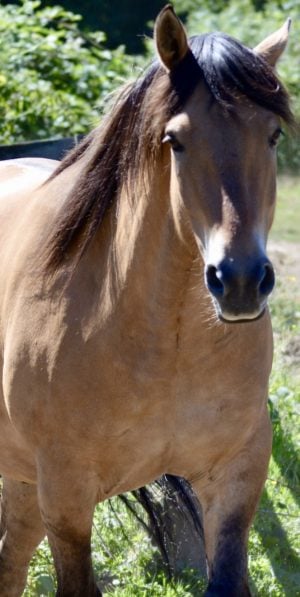
Did you know that Spring and Winter are the most common times for horses to get lice? Montaro got a lice infestation in his forelock and mane a couple years ago – then passed some of them to Jax and Juno. Interestingly, none of the other horses had lice anywhere. I eliminated them all very quickly using a natural, herbal formula and by either manually removing them with a steel nit comb, or by zapping them with a battery operated lice comb.
You can use either method of removal, but the zapper lice comb (RobiComb) is much easier and faster. I did a whole round of treatment using a manual nit comb, then I switched to the RobiComb zapper and I vastly prefer it. But I will give you instructions for both below.
The good news is that horse/deer lice are much bigger than human lice and are quite easy to see. Wear a hat and tie your hair back though, because they will try to jump onto your head! Luckily, they do not live or breed on humans. And once they are off the blood host, lice only live 1-3 days.
The other big reason you may want to use this natural horse lice remedy, is that most lice are now unaffected by current pesticides (lice shampoo or chemical treatments). Just like chemical wormers, which have been overused, so the worms have evolved immunity against the drug worm treatments, the same thing has happened with lice pesticides.
So let’s get started…
Step 1: Electrocute the live lice OR Nit comb them out
As I said, you can either manually nit comb the lice and eggs, or you can electrocute them as you comb them out using the RobiComb. The key difference to keep in mind is that if you’re using the RobiComb electric zapper, you don’t need to add oil or hair conditioner first – you just zap them dry. If you’re using a steel nit comb, then you may want to use olive oil, or hair conditioner, to get the strands lubricated first – it can make it easier to slide the comb along.
Using the RobiComb zapper
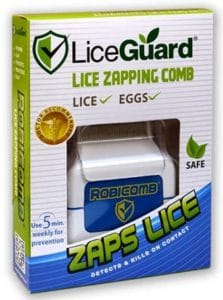
The device gives off a fairly high-pitched whine noise; which abruptly stops when it zaps a critter, so you know when you got one (intensely satisfying). I thought animals would hate the noise, but my horses, dogs and cats are all fine with it! Believe it or not, they all actually seemed to enjoy the lice-zapper comb.
I’m not sure whether the RobiComb also kills the lice eggs upon contact. But if you wanted to be sure, you could either comb the eggs out using a regular lice comb – I like this stainless steel one – or use the RobiComb weekly for 3 weeks. This video shows you exactly how the RobiComb works, or you can watch my video below where I show you how I use it on the horses.
Using a steel nit comb
If you are manually nit combing, then comb out hair tangles first, and coat the hair generously with olive oil or human hair conditioner. You can try dry combing, but I find that pulls out a lot of hair. I find the hair needs to be slippery to be able to get the nit comb through easily and to pull the eggs off the hair strand. Use a stainless steel nit comb with tight grooves – don’t waste your time on plastic ones.
Whether you’re combing with the RobiComb or steel nit comb, make sure you get right down the skin (where the live lice are feeding) and comb up/out from there.
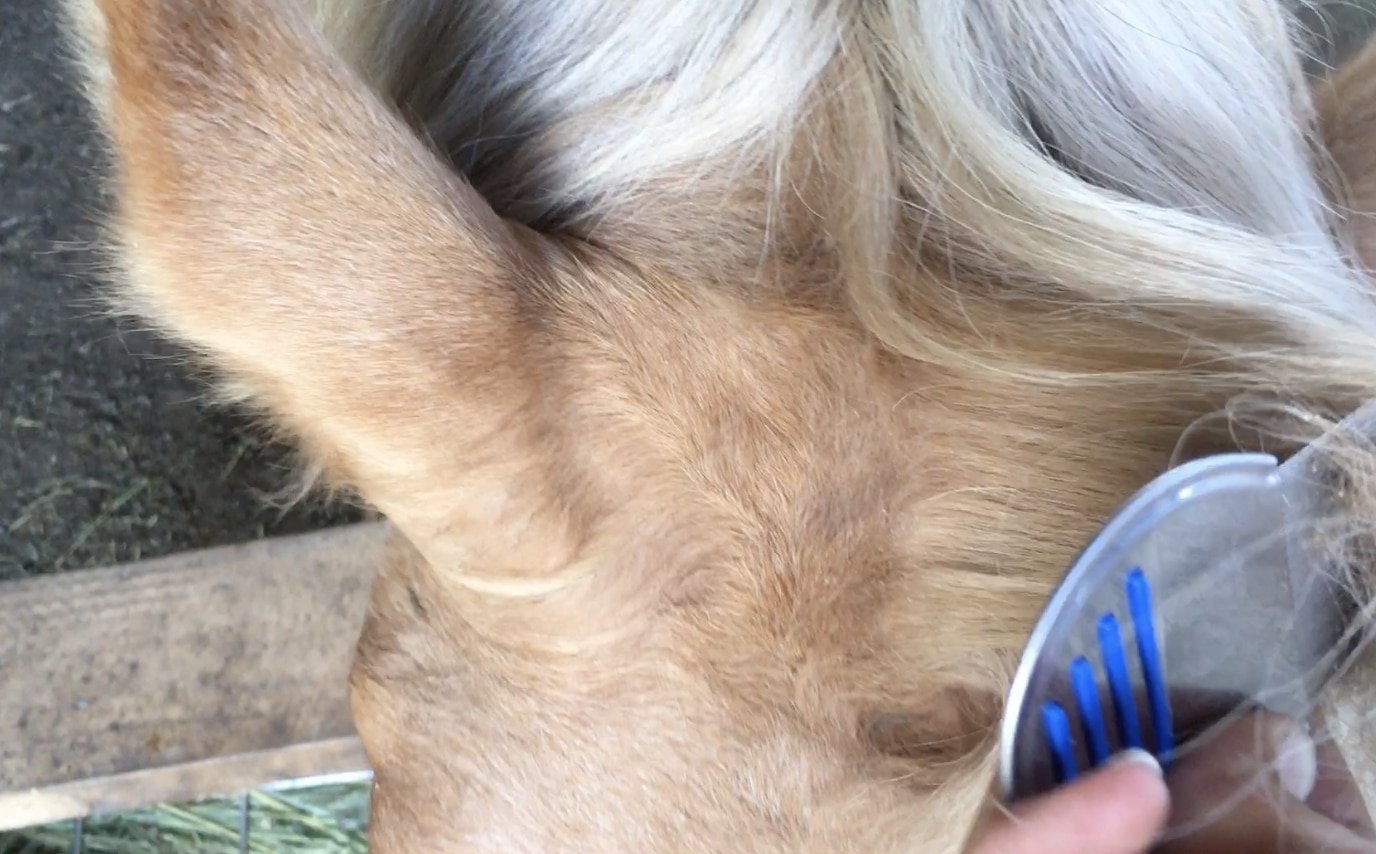
You’ll need to section up the hair and comb from every angle to be able to remove all the eggs. If the steel nit comb keeps snagging, then add more olive oil or hair conditioner to increase lubrication.
As the steel nit comb gets full of eggs, wipe it off on a paper towel. Keep the paper towel away from the horse in case there are any live lice wiped off – you don’t want them jumping back on.
During this stage of treatment, lice comb away from other horses and don’t comb over hay or grass where the lice could jump onto another host in a few hours. Remember lice can live 1-3 days off the blood host.
After you’ve applied the lice remedy below and the nymphs and adults are dead, then you can be more relaxed about nit combing over a slow feeder or hay pile.
Step 2: Apply natural lice remedy
Prepare this natural lice remedy to apply to all areas infested with lice. I thought Montaro only had them in his forelock and the top bit of his mane, but a couple days later he pointed to his hind legs, flank and sheath area and I found them there too!
Essential Oils Horse Lice Remedy
- 1/4 cup olive oil
- 1 teaspoon tea tree oil (essential oil)
- 1 tsp + 2 dropperfuls (OR 6 dropperfuls @ 30 drops per dropperful) wild oregano oil (NOT essential oil; use a commercial brand that has already been diluted 3:1)
Shake or whisk together to mix well. Double this recipe if you have a large infestation, or more than two horses affected.
*Note: This is a very strong formula, so avoid contact with eyes and be careful around mucous membranes (nostrils, penis, udder).
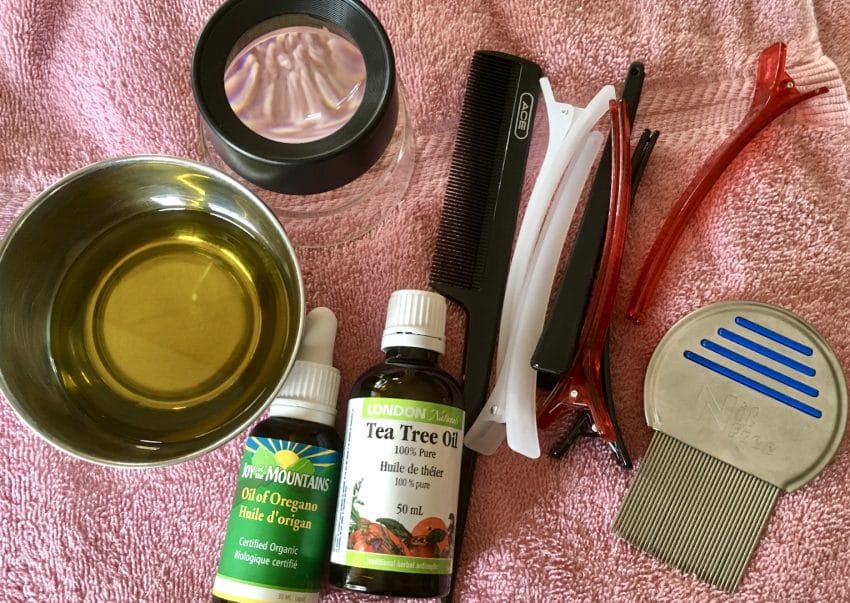
You can either apply this remedy with your fingers, or put it in a small spray bottle. I found it easiest to spray it on. I would direct the spray to saturate the roots of the mane or forelock and then use my fingers to work it along the length of the hair.
Remember, the lice are feeding from the blood in the skin, so if you cover the skin with the remedy, as much as you can, that will prevent further feeding. This essential oil remedy will kill the adults and the nymphs (youngsters).
This vet report says that insecticides don’t kill lice eggs, so I’m not sure whether this formula would kill the eggs or not. However, this study shows that numerous essential oils outperform the most common insecticides (delta-phenothrin and pyrethrum) in killing adult lice. And this study shows that tea tree oil outperforms both pyrethrins and piperonyl butoxide insecticides. I’ve seen clinical studies showing that wild oregano kills yeast, bacteria, viruses and some parasites in humans, but there are no trials on it’s use with lice eggs. So best to err on the side of caution.
As I outlined above, I first removed as many lice and eggs as I could with either a steel lice comb or the RobiComb. Then I applied this essential oil remedy and left it for a day.
The next day, I again followed Step 1 above. If I found any live lice, I applied the remedy again to those areas. I continued this process daily until all the live lice were gone and I could no longer see or comb out any lice eggs. It doesn’t take more than 3 – 7 days to get horses clear of lice.
Then check every week for a few weeks in case you missed a few. One female can produce 150 – 300 eggs, so if you missed a few, it won’t take long until they’re infested again.
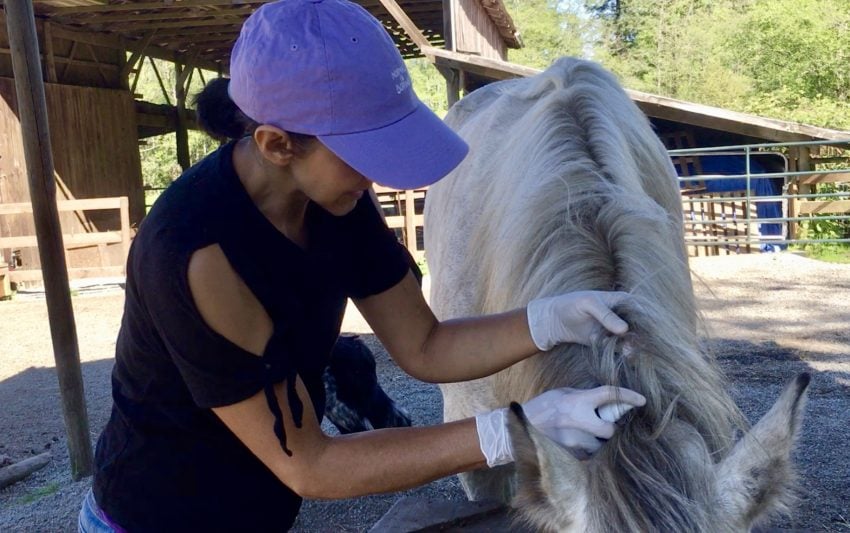
Of course, you also need to sterilize any combs, brushes, grooming tools, fly masks, horse blankets and any other gear that you use. The easiest way is bag them up, seal them tightly and put them away for a week. Remember lice cannot live for more than 2-3 days off the blood host. Blankets and fly masks can be washed and thrown in a hot dryer for at least 20 minutes on high heat, as that will also kill lice and eggs.
If you already have some diatomaceous earth lying around, you can also use that after lice combing, if you wish. Diatomaceous earth (DE) kills parasites and insects by absorbing bodily fluids into it’s porous surface. Just be careful not to inhale the powder as the super tiny particles can irritate your lungs. However, I don’t know if DE affects the eggs, so you may want to just stick to the essential oils remedy – or test it and let us know!
NOTE: In my second experience treating lice on horses, I just skipped the whole nit comb step (which is most labor intensive) and went straight to applying the remedy. I also used the RobiComb on any body hair as it’s super fast (but not mane, forelock as too time-consuming), and then applied the remedy. This worked just as well as doing the whole nit-combing routine – if any eggs hatched, I just applied the remedy again. In a few weeks all was completely clear.
But why kill the lice?
After thoroughly eliminating all lice and eggs, I then gave extra herbs for the next year, to bolster the lads’ immune systems. Remember, it’s not the germ/parasite/pathogen that’s the problem – it’s the bio-terrain of the host. If your immune system is strong and healthy, you won’t contract whatever is going around.
Well, the next Spring, lo and behold, Montaro had lots of lice again! Jax and Juno had only a few. And none of the other horses had any. So I went into things a little deeper than just the physical parameters and I realized a few other factors were at work:
1. Montaro was still dealing with his emotional issues from being castrated – which didn’t completely release until his last craniosacral session with Ainsley, a few months later.
Yes! Emotions have a strong effect on the immune system. As do beliefs and stress levels. Did you know that people with Multiple Personality Disorder can have an extreme allergy while in one personality, that completely disappears when they’re in another personality? So in one personality, for example, peanuts will put them into anaphylactic shock. But in another personality they can eat peanuts, peanut butter, etc. with zero reaction. Dr. Bruce Lipton (geneticist) has a fabulous book/audio where he goes in-depth into how our beliefs affect our biology.
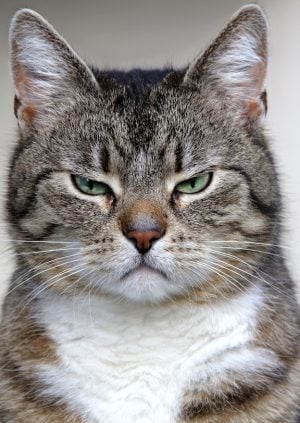
3. The townhome developments in our area are pushing massive numbers of deer onto the few remaining tracts of undeveloped land. Along with a lot of coyotes and even bobcats. So there are a lot of stressed animals in the area. How might this be affecting the herd’s ecosystem?
However, that doesn’t explain why most of the herd did not get infested with lice.
As I dialogued with Montaro about these things, his essential message to me was, “Just chill.” So I decided to observe and dialogue more, rather than go Rambo on the critters.
Montaro told me not to treat/kill the lice on him. But Jax and Juno allowed them to be removed. As I observed Montaro and his lice buddies, I noticed that they just naturally lived out their cycle and then disappeared as summer came. They had no ill effect on Montaro, or the other horses. He didn’t even itch much.
I’m looking more at the symbiosis of creatures these days… what could the benefits be to the host of having lice? What is the role of lice in the ecosystem? There doesn’t seem to be a lot of interest or research into this aspect of lice, but I did find some interesting nuggets here and here:
- Lice are believed to have started out only eating dead skin (and feathers on birds) and then at some point evolved to breaking the skin and sucking blood.
- But lice that only eat blood do not get all the nutrients they need, so the bacteria in their gut has evolved to compensate for the missing vitamins and amino acids.
- Lice outbreaks are commonly found on diseased or senile animals – this reminds me of natural selection. The same thing occurs in plants – when you get a lot of unhealthy plants, that’s when you can get a locust plague. Nature uses fire to purge a forest, or stimulate growth on grasslands. Perhaps a similar mechanism is at work here.
- In certain South American Indian tribes, people remove and eat the lice from each other’s body. This is seen as sharing each other’s soul.
Montaro is also in excellent health… perhaps he knows the lice are no threat to him. Perhaps he is happy to play his role in the lice’s ecosystem…?
When we look at an ecosystem, we can’t just look at how other beings benefit or fit into our circle. We also have to look at how we benefit others who also desire to live and have a place on this planet. Not saying we have to agree or be happy about it! But the more we can understand the biosphere, the more intelligent choices we can make.
Now that Montaro’s issues over his castration have (I believe) been resolved. And the lads are off on the adventure they asked for when they first took off North down Highway 15. I wonder if he will get lice this Spring up at Kesia’s place?
Have the lice eggs hibernated under his coat, close to his skin for warmth during the winter, ready to hatch again in the Spring? Or are they actually gone because he is either no longer susceptible, or his spirit is no longer resonating with their energy/role? I look forward to the next chapter in this story and will keep you posted!

p.s. If you’re trying to get rid of human lice, then follow the directions in this post from my health blog.
Note: The RobiComb lice zapper works equally well on fleas. It doesn’t kill the fleas, but it stuns them so they let go and then you can kill them.
We once got a new kitten who was covered in fleas, so I would lice comb him as he ate, about three times a day. In a few days he was completely clear of fleas and didn’t pass them on to any of the other dogs or cats in the house. He actually grew to enjoy the combing/zapping sessions. But interestingly, by day 2 the fleas had learned what the high-pitched whine meant and they would scurry away from it. In my defense, before I began, I took the kitten outside and told the fleas to jump off if they wanted to avoid being killed.
2023 UPDATE: Upon moving to Kesia’s place, all the lice disappeared and 5 years later, have never reappeared, on any of the horses. I think the emotional issues were KEY.

Jini Patel Thompson is a natural health writer and Lazer Tapping instructor. She began riding at age 2 in Kenya, and got her first horse at age 8 in Alberta, and so continues a life-long journey and love affair with these amazing creatures.








Do you have horse lice shampoo in Australia where do you buy it what factory what does he buy it the lice shampoo flys are always on my horse all the time please send it to my email address is [xxx@gmail.com] thankyou 🐎🐎
Hi Cindy, I changed your email so it wouldn’t appear and be picked up by spammers 😉 But no, we don’t carry any lice shampoo. You can use the formula I give in the video if you like.
Hi, I read your article, and just wanted to reach out from the UK and say that from my perspective, yes, emotions are energy in motion. They have everything to do with what transpires into our experience. I’ve spent 15 years working with horses who have had ‘trauma’ or ‘unresolved health issues’ and found this to the case in all of them, albeit expressing in different ways. I’ve seen what many would say ‘impossible’ turnarounds, and am the eternal student of the wisdom each horse brings. Once our emotions are allowed to flow, and we change our frequency, we experience a new reality, nothing hangs around extraneously. It was my complete joy to read you ‘communicate’ to your horses too. Thank you so much for such an enjoyable, relatable read!
Very well said/explained Claire! Thanks so much for your comment. If you select the Spiritual Equine category, there are many more posts like this:
https://listentoyourhorse.com/category/spiritual-equine/
Enjoy 🙂